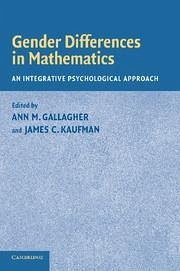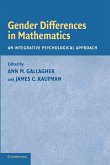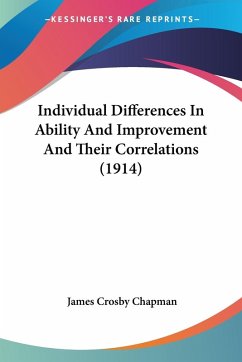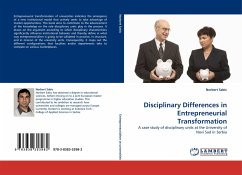Short description/annotation
This book explores gender differences in math performance.
Main description
Females consistently score lower than males on standardized tests of mathematics - yet no such differences exist in the classroom. These differences are not trivial, nor are they insignificant. Test scores help determine entrance to college and graduate school and therefore, by extension, a person's job and future success. If females receive lower test scores then they also receive fewer opportunities. Why does this discrepancy exist(?)33; This book presents a series of papers that address these issues by integrating the latest research findings and theories. Authors such as Diane Halpern, Jacquelynne Eccles, Beth Casey, Ronald Nuttal, James Byrnes, and Frank Pajares tackle these questions from a variety of perspectives. Many different branches of psychology are represented, including cognitive, social, personality/self-oriented, and psychobiological. The editors then present an integrative chapter that discusses the ideas presented and other areas that the field should explore.
Table of contents:
Preface; 1. Research on the women and mathematics issue: a personal case history Susan Chipman; 2. The perseverative search for sex differences in mathematic ability Paula Caplan and Jeremy Caplan; 3. A psychobiosocial model: why females are sometimes > and sometimes < males in math achievement Diane Halpern, Jonathan Wai and Amanda Saw; 4. Gender differences in math: cognitive processes in an expanded framework James Byrnes; 5. Cognitive contributions to sex differences in math performance James M. Royer and Laura M. Garofoli; 6. Spatial ability as a mediator of gender differences on mathematics tests: a biological-environmental framework M. Beth Casey, Ronald Nuttal and Elizabeth Pezaris; 7. Examining gender-related differential item functioning using insights from psychometric and multicontext theory Rob Ibarra; 8. The gender-gap artifact: women's underperformance in quantitative domains through the lens of stereotype threat Paul Davies and Steve Spencer; 9. 'Math is hard!' (Barbie, 1994): responses of threat vs challenge mediated arousal of stereotypes alleging intellectual inferiority Talia Ben Zee, Cristina M. Carrasquillo, Alison M. L. Ching, Tattiya J. Kliengklom, Kristen L. McDonald, Daniel C. Newhall, Gillian E. Patton, Tiffany D. Stewart, Tonya Stoddard, Michael Inzlicht and Steve Fein; 10. The role of ethnicity on the gender gap in mathematics Alyssa Walters and Lisa Brown; 11. The gender gap in mathematics: merely a step function Sophia Catsambis; 12. 'I can, but I don't want to': the impact of parents, interests, and activities on gender differences in math Janis E. Jacobs, Pamela Davis-Kean, Martha Bleeker, Jacquelynne S. Eccles and Oksana Malachuk; 13. Gender effects on mathematics achievement: mediating role of state and trait self-regulation Eunsook Hong, Harold O'Neil and David Feldon; 14. Gender differences in mathematics self efficacy beliefs Frank Pajares; 15. Integrative conclusion Ann Gallagher and James Kaufman.
Hinweis: Dieser Artikel kann nur an eine deutsche Lieferadresse ausgeliefert werden.
This book explores gender differences in math performance.
Main description
Females consistently score lower than males on standardized tests of mathematics - yet no such differences exist in the classroom. These differences are not trivial, nor are they insignificant. Test scores help determine entrance to college and graduate school and therefore, by extension, a person's job and future success. If females receive lower test scores then they also receive fewer opportunities. Why does this discrepancy exist(?)33; This book presents a series of papers that address these issues by integrating the latest research findings and theories. Authors such as Diane Halpern, Jacquelynne Eccles, Beth Casey, Ronald Nuttal, James Byrnes, and Frank Pajares tackle these questions from a variety of perspectives. Many different branches of psychology are represented, including cognitive, social, personality/self-oriented, and psychobiological. The editors then present an integrative chapter that discusses the ideas presented and other areas that the field should explore.
Table of contents:
Preface; 1. Research on the women and mathematics issue: a personal case history Susan Chipman; 2. The perseverative search for sex differences in mathematic ability Paula Caplan and Jeremy Caplan; 3. A psychobiosocial model: why females are sometimes > and sometimes < males in math achievement Diane Halpern, Jonathan Wai and Amanda Saw; 4. Gender differences in math: cognitive processes in an expanded framework James Byrnes; 5. Cognitive contributions to sex differences in math performance James M. Royer and Laura M. Garofoli; 6. Spatial ability as a mediator of gender differences on mathematics tests: a biological-environmental framework M. Beth Casey, Ronald Nuttal and Elizabeth Pezaris; 7. Examining gender-related differential item functioning using insights from psychometric and multicontext theory Rob Ibarra; 8. The gender-gap artifact: women's underperformance in quantitative domains through the lens of stereotype threat Paul Davies and Steve Spencer; 9. 'Math is hard!' (Barbie, 1994): responses of threat vs challenge mediated arousal of stereotypes alleging intellectual inferiority Talia Ben Zee, Cristina M. Carrasquillo, Alison M. L. Ching, Tattiya J. Kliengklom, Kristen L. McDonald, Daniel C. Newhall, Gillian E. Patton, Tiffany D. Stewart, Tonya Stoddard, Michael Inzlicht and Steve Fein; 10. The role of ethnicity on the gender gap in mathematics Alyssa Walters and Lisa Brown; 11. The gender gap in mathematics: merely a step function Sophia Catsambis; 12. 'I can, but I don't want to': the impact of parents, interests, and activities on gender differences in math Janis E. Jacobs, Pamela Davis-Kean, Martha Bleeker, Jacquelynne S. Eccles and Oksana Malachuk; 13. Gender effects on mathematics achievement: mediating role of state and trait self-regulation Eunsook Hong, Harold O'Neil and David Feldon; 14. Gender differences in mathematics self efficacy beliefs Frank Pajares; 15. Integrative conclusion Ann Gallagher and James Kaufman.
Hinweis: Dieser Artikel kann nur an eine deutsche Lieferadresse ausgeliefert werden.








